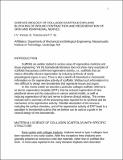Surface biology of collagen scaffold explains blocking of wound contraction and regeneration of skin and peripheral nerves
Author(s)
Yannas, Ioannis V; Tzeranis, Dimitrios; So, Peter T. C.
DownloadYannas_Surface Biology with SI.pdf (1.918Mb)
OPEN_ACCESS_POLICY
Open Access Policy
Creative Commons Attribution-Noncommercial-Share Alike
Terms of use
Metadata
Show full item recordAbstract
We review the details of preparation and of the recently elucidated mechanism of biological (regenerative) activity of a collagen scaffold (dermis regeneration template, DRT) that has induced regeneration of skin and peripheral nerves (PN) in a variety of animal models and in the clinic. DRT is a 3D protein network with optimized pore size in the range 20–125 µm, degradation half-life 14 ± 7 d and ligand densities that exceed 200 µM α1β1 or α2β1 ligands. The pore has been optimized to allow migration of contractile cells (myofibroblasts, MFB) into the scaffold and to provide sufficient specific surface for cell–scaffold interaction; the degradation half-life provides the required time window for satisfactory binding interaction of MFB with the scaffold surface; and the ligand density supplies the appropriate ligands for specific binding of MFB on the scaffold surface. A dramatic change in MFB phenotype takes place following MFB-scaffold binding which has been shown to result in blocking of wound contraction. In both skin wounds and PN wounds the evidence has shown clearly that contraction blocking by DRT is followed by induction of regeneration of nearly perfect organs. The biologically active structure of DRT is required for contraction blocking; well-matched collagen scaffold controls of DRT, with structures that varied from that of DRT, have failed to induce regeneration. Careful processing of collagen scaffolds is required for adequate biological activity of the scaffold surface. The newly understood mechanism provides a relatively complete paradigm of regenerative medicine that can be used to prepare scaffolds that may induce regeneration of other organs in future studies.
Date issued
2015-12Department
Massachusetts Institute of Technology. Department of Biological Engineering; Massachusetts Institute of Technology. Department of Mechanical EngineeringJournal
Biomedical Materials
Publisher
IOP Publishing
Citation
Yannas, IV, D Tzeranis, and P T So. “Surface Biology of Collagen Scaffold Explains Blocking of Wound Contraction and Regeneration of Skin and Peripheral Nerves.” Biomedical Materials 11, no. 1 (December 23, 2015): 014106.
Version: Author's final manuscript
ISSN
1748-605X